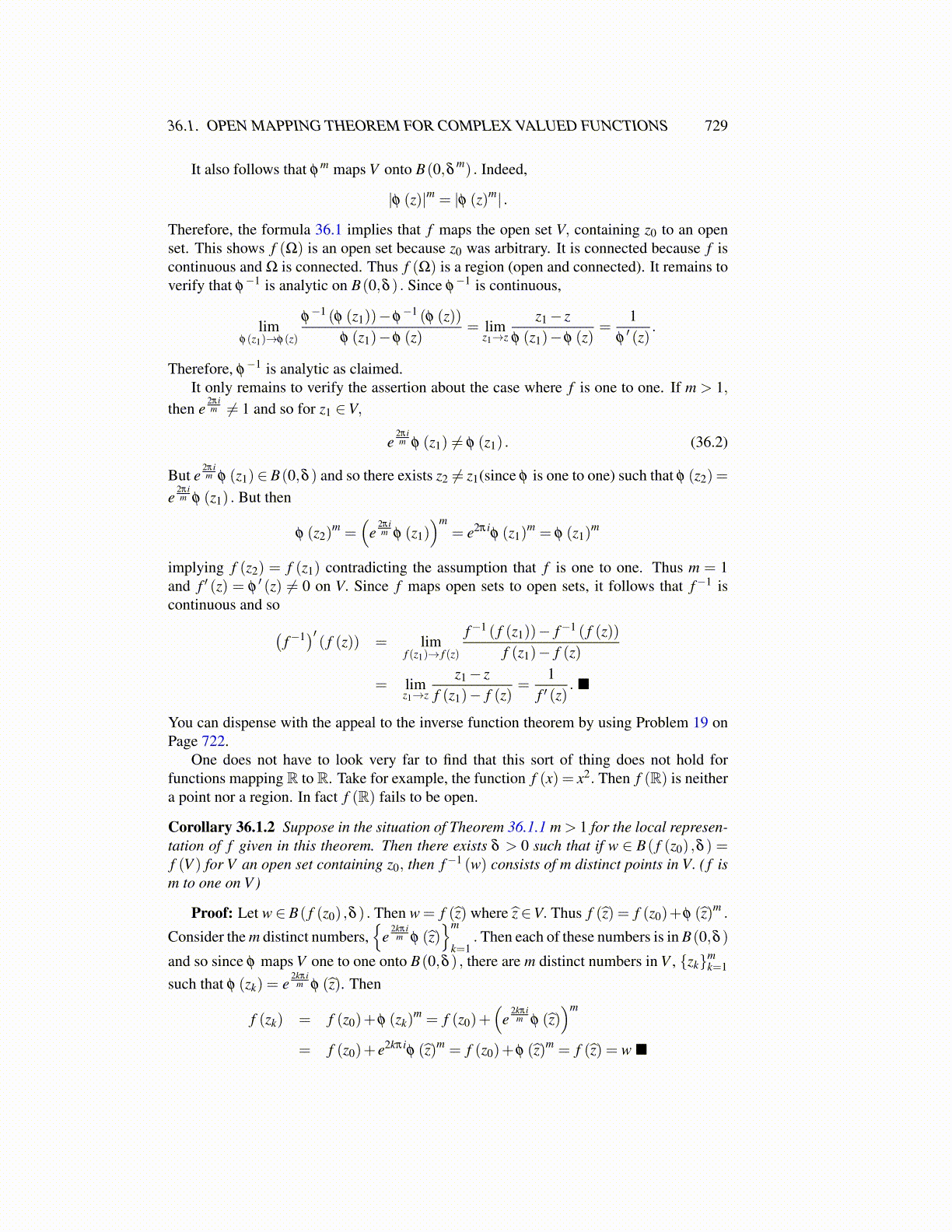
36.1. OPEN MAPPING THEOREM FOR COMPLEX VALUED FUNCTIONS 729
It also follows that φm maps V onto B(0,δ m) . Indeed,
|φ (z)|m = |φ (z)m| .
Therefore, the formula 36.1 implies that f maps the open set V, containing z0 to an openset. This shows f (Ω) is an open set because z0 was arbitrary. It is connected because f iscontinuous and Ω is connected. Thus f (Ω) is a region (open and connected). It remains toverify that φ
−1 is analytic on B(0,δ ) . Since φ−1 is continuous,
limφ(z1)→φ(z)
φ−1 (φ (z1))−φ
−1 (φ (z))φ (z1)−φ (z)
= limz1→z
z1− zφ (z1)−φ (z)
=1
φ′ (z)
.
Therefore, φ−1 is analytic as claimed.
It only remains to verify the assertion about the case where f is one to one. If m > 1,then e
2πim ̸= 1 and so for z1 ∈V,
e2πim φ (z1) ̸= φ (z1) . (36.2)
But e2πim φ (z1)∈ B(0,δ ) and so there exists z2 ̸= z1(since φ is one to one) such that φ (z2) =
e2πim φ (z1) . But then
φ (z2)m =
(e
2πim φ (z1)
)m= e2πi
φ (z1)m = φ (z1)
m
implying f (z2) = f (z1) contradicting the assumption that f is one to one. Thus m = 1and f ′ (z) = φ
′ (z) ̸= 0 on V. Since f maps open sets to open sets, it follows that f−1 iscontinuous and so(
f−1)′ ( f (z)) = limf (z1)→ f (z)
f−1 ( f (z1))− f−1 ( f (z))f (z1)− f (z)
= limz1→z
z1− zf (z1)− f (z)
=1
f ′ (z). ■
You can dispense with the appeal to the inverse function theorem by using Problem 19 onPage 722.
One does not have to look very far to find that this sort of thing does not hold forfunctions mapping R to R. Take for example, the function f (x) = x2. Then f (R) is neithera point nor a region. In fact f (R) fails to be open.
Corollary 36.1.2 Suppose in the situation of Theorem 36.1.1 m > 1 for the local represen-tation of f given in this theorem. Then there exists δ > 0 such that if w ∈ B( f (z0) ,δ ) =f (V ) for V an open set containing z0, then f−1 (w) consists of m distinct points in V. ( f ism to one on V )
Proof: Let w ∈ B( f (z0) ,δ ) . Then w = f (ẑ) where ẑ ∈V. Thus f (ẑ) = f (z0)+φ (ẑ)m .
Consider the m distinct numbers,{
e2kπi
m φ (ẑ)}m
k=1. Then each of these numbers is in B(0,δ )
and so since φ maps V one to one onto B(0,δ ) , there are m distinct numbers in V , {zk}mk=1
such that φ (zk) = e2kπi
m φ (ẑ). Then
f (zk) = f (z0)+φ (zk)m = f (z0)+
(e
2kπim φ (ẑ)
)m
= f (z0)+ e2kπiφ (ẑ)m = f (z0)+φ (ẑ)m = f (ẑ) = w ■